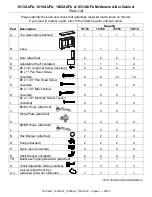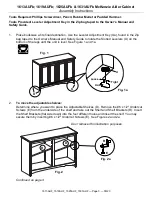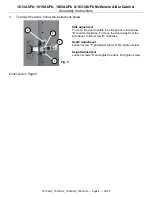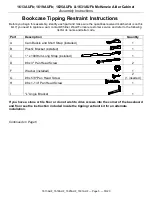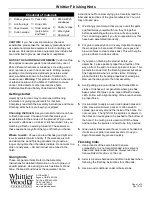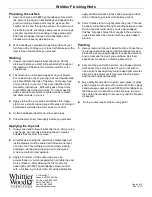
Whittier Finishing Hints
P.O. Box 2827
Eugene, OR 97402 USA
Toll Free: 800-653-3336
Ph: 541-687-0213
Fax: 541-687-2060
www.whittierwood.com
Page 1 of 2
Rev. 10/13
Checklist of materials
□
Rubber gloves
□
Lint-free rags
□
Paper towels
□
Cotton swabs
□
Tack cloth
□
Drop cloth
□
Stain brushes
(poly bristle
and foam)
□
#220 & #320
sandpaper
□
Painter’s tape
□
Wood glue
□
Dust mask
CAUTION:
If you have environmental or chemical
sensitivities, please take the necessary precautions and
use personal protective equipment to aid in limiting your
exposure. Personal protective equipment may include but
are not limited to gloves, dust masks or respirators.
NOTICE TO CALIFORNIA CUSTOMERS
: California Prop
65 requires consumer goods to be labeled if any one of
850+ different chemicals or substances, including wood
dust, is present, even in trace amounts. Drilling, sawing,
sanding or machining wood products generates wood
dust, a substance known to the State of California to
cause cancer.
Warning
: This product contains a chemical
or substance known to the State of California to cause
cancer, birth defects or other reproductive harm.
California Health and Safety Code Section 25249.6
Getting started
Assembly Instructions may contain special finishing
information or gluing requirements for that item.
Completely read both the Assembly Instructions and these
Finishing Hints before you begin your project.
Choosing the finish:
Ask your retailer for advice on how
to finish bare wood. Choose a finish that meets your
expectations for the end use of the product. Will you use it
as a work surface as on a desk or kitchen island? Are you
matching a finish on existing furniture? The answers to
these questions may affect the type of finish you choose.
Where to work:
Choose an area that has good light and
is well ventilated, warm and dry. If the work area is cold
and damp, the wood finishing products may require a
longer drying time than the labels indicate. Do not work in a
dirty or dusty area – dirt and/or dust can embed in the
finish.
Gluing hints
These are general hints. Refer to the Assembly
Instructions for detailed information on how to glue your
specific product. Use wood glue such as Elmer’s Wood
Glue, Titebond Wood Glue or the equivalent. Some
instructions call for a slow drying glue. Carefully read the
label and instructions of the glue manufacturer. Your unit
may not need glue.
1.
We strongly recommend that you lay out all the parts
and familiarize yourself with how they fit together
before assembling with glue. Glue will set up quickly.
You can damage parts if you try to reposition any that
have been assembled incorrectly.
2.
For glue to properly bond, it is very important to apply
the wood glue to bare wood. Protect your eyes and
blow into holes to clear excess dust. This will help the
glue to adhere to a clean surface.
3.
If you plan on finishing the product before you
assemble it, place painter’s tape three-fourths of the
way up from the end of a dowel, spindle or tenon. This
protects the ends from the finishing product but allows
finish application where it will be visible. Finishing
products inhibit the bonding properties of wood glue.
Remove the tape prior to the final assembly.
4.
Avoid getting glue on surfaces to be finished. Most
stains or finishes will not penetrate where glue has
been spilled. Wet glue can be wiped off with a damp
cloth. Follow with a light sanding of the area to ensure
a proper finish.
5.
It is important to apply an even coat inside holes and
slots. Use a small dowel, pencil or cotton swab to
spread glue evenly around the inside of the holes. Do
not over glue. The tight fit of the spindles or dowels in
the holes can cause glue to be pushed to the bottom of
the hole. If too much glue is used it will fill the holes
and not allow the spindle or dowel to be fully inserted.
6.
Glue usually takes several hours to cure or harden but
it will set up or grab in several seconds. Once you
begin final assembly, proceed quickly.
Finishing hints
1.
Use products of the same brand to ensure
compatibility. It is not recommended to mix solvent
based and water based finishes
.
Always read and
follow all label directions on the can.
2.
Alder is a porous hardwood and often looks best when
following the finishing instructions for softwoods.
3.
Use a wood conditioner under oil base stains.


